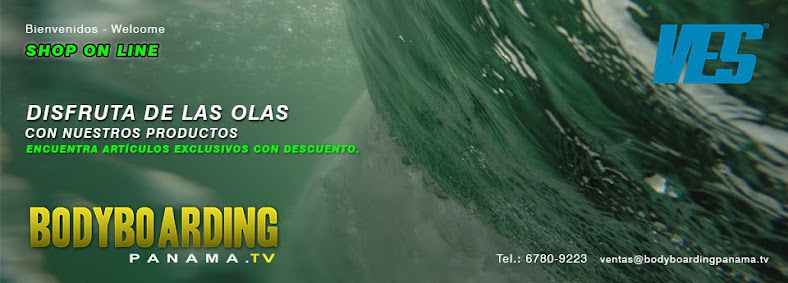"este artículo habla de la historia del bodyboarding, y menciona entre otras cosas, a Panamá como potencia MUNDIAL de este radical deporte."
Bodyboarding (aka Boogie Boarding)
"F#$&in' spongers!"
Now that we've expressed the feeling of most upright surfers, we are free to discuss bodyboarding. There is no easier way to engage in surfing (i.e. the sport of riding the crests of waves, especially, but not necessarily, on a surfboard). No vehicle on earth rides more waves. Tens of millions of people have lain on their bellies, kicked their feet and giddily harnessed nature's forces toward the shore. Bodyboards are available at surf shops, tourist traps, even drug stores. In a sense, you could say bodyboards rule.
For thousands of years, Polynesians rode waves in the prone position on short slabs of wood, bundles of reeds, palm frond stems or anything else that would float them and plane across the water. "Paipo," a Hawaiian term referring to a small board, 4 feet or less in length, was long considered a pastime for children before progressing to true surfing. Stand-up surfing, on a board usually over 6 feet, gained acceptance in Hawaii and found its way around the globe with Duke Kahanamoku in the early 20th century. Also known as bellyboards, paipos weren't as widely used but remained in existence through the '60s. The idea of prone surfing would soon find its ultimate medium.
On July 7, 1971, the bodyboard was born. Tom Morey, a surfboard builder with a background in math and engineering, had left his California surfboard business to relax and design on the island of Hawaii. On that fateful day, staring out at the surf without a board to ride, Morey borrowed an electric carving knife and a household iron, whittled some scrap polyethylene foam into a small rectangular mat and covered it with newspaper. He found his invention (first dubbed S.N.A.K.E. -- side, navel, arm, knee, elbow) easy to produce and even easier to navigate. In 1973, he trademarked the name Morey Boogie for $10 and scrounged together enough money to place a quarter-page ad in Surfing magazine.
Demand for Morey's boards was incredible. By 1977, he was producing 80,000 per year, mainly sold in the United States. The next year, Morey-Boogie was purchased by Kransco (and later resold to Whamo, Inc. in 1998, with Morey hired as a consultant). Here was an activity that, unlike surfing, offered a gentle learning curve and could be enjoyed immediately by even the most sedentary of people. Boards were affordable -- less than $100 for the top of the line and 10 bucks for a drugstore special -- and the sport caught on worldwide.
As lineups become congested with bodyboarders, many of them incompetent, resentment toward the sport quickly grew. Most surfers looked upon them as second-class citizens, refusing to yield on a wave and creating derogatory monikers such as spongers, cripples and speed bumps. Like it or not, bodyboarding was here to stay, and it soon found its way into competition.
The first professional bodyboarding contest was the 1979 Morey/Gap event at Huntington Beach, won by Californian Mike Lambresi, who evolved to conventional surfing and went on the become a three-time U.S. professional champion. From there, the Surecraft/Coca-Cola Challenge was held at Pipeline the next year, boasting a $5,000 purse and won by John Patterson. In 1982, Pipe became host for an event known as the World Bodyboarding Championships, an annual gathering determining the king of the sport and continuing to this day. Bodyboarding found its first hero the next year in blond-haired, blue-eyed Hawaiian Mike Stewart. Dominant under any conditions, Stewart was a maestro at Pipe, winning that event a record 11 times, not to mention being an eight-time U.S. champion. Considered the world's premier big-wave barrel, Pipeline was merely survived by stand-up surfers, while Stewart made it his personal playground. He rode it deeper than any other human and launched unfathomable aerials and barrel rolls on sections other people avoided completely. Still among the world's top riders at the end of the '90s, Stewart eased into semi-retirement. His legacy, however, remains as bodyboarders routinely ride deepest and fly highest of all waveriders.
In contrast to surfing, which remains dominated by the United States and Australia, bodyboarding has acquired more multicultural control. While those countries still produce some viable contenders, many of the world's top bodyboarders now hail from Brazil, South Africa, Portugal, Puerto Rico, Venezuela, Panama and the Canary Islands. Guilherne Tamega from Brazil set the pace by rising to topple Stewart in 1995, becoming the first Global Organization of Bodyboarding World Champion. Unable to crack the upper echelons of the ASP (except for Brazil), these countries embraced bodyboarding, promoting it through extensive television and magazine coverage. Meanwhile, U.S. surfwear companies withdrew their support during the difficult period in the early '90s and have yet to reinvest.
It didn't take long for bodyboarding to usurp surfing in terms of numbers; the cheap and easy road will always be the most trodden. But bodyboarding has gone a step further. The most progressive-minded surfers in the world, led by Kelly Slater, are now pursuing bodyboarders when it comes to defining future performance standards. For example, Slater attempted an A.R.S., or aerial reverse spin, during the 1999 Pipe Masters. Where Slater goes, so goes surfing. In that case, we'd better keep our eyes on those f#$&in' spongers. -- Jason Borte, November 2000
NO SABES INGLÉS??? COPIA EL TEXTO Y BUSCA EN GOOGLE TRADUCTOR, Y PUEDES LEERLO EN ESPAÑOL, O CUALQUIER OTRO IDIOMA DEL PLANETA.
VES? COMUNÍCATE!
